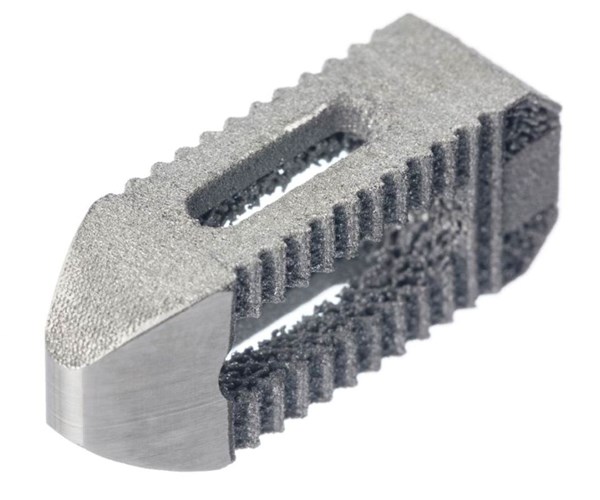Advanced Material in Additive Manufacturing Produces Better Spinal Implant
A highly porous alloy makes it possible to build an implant that more closely imitates the structure of natural bone.
Share







Autodesk, Inc.
Featured Content
View More



Stryker's additively manufactured PL spine cage is made from Tritanium, a highly porous titanium alloy capable of building randomized structures that closely imitate natural cancellous bone.
Natural cancellous bone (the spongy bone tissue found inside vertebrae and at the ends of large bones) grows in a random arrangement of bridges and cavities. Conventionally machined implants aim to imitate this with rough coatings to help anchor the devices and encourage the in-growth of bone tissue. The problem with this method is that the natural bone can only grow as deep as the coating, and there is a danger that the coating may eventually detach from the implant itself.
Metal additive manufacturing solves these problems with its ability to build hollow structures that are more similar to cancellous bone. Natural bone can grow deep into the interior of porous implants made with AM, making for an implant that is far more secure in the body. Medical manufacturer Stryker has developed a strategy for manufacturing spine implants that combines Tritanium, a proprietary titanium alloy, with the company’s Laser Rapid Manufacturing technique, a laser-driven additive manufacturing process.
The Tritanium material is a highly porous titanium alloy designed specifically for bone in-growth and biological fixation. It has a mean porosity of 60 percent; by comparison, the mean porosity of natural cancellous bone ranges from 50 to 90 percent. Cancellous bone also has a mean pore diameter of 1 mm, though pore diameters vary widely and randomly. Thanks to the additive manufacturing technique, it is possible to imitate this structure in Tritanium, with pore diameters ranging from 100 to 700 microns in a random architecture.
Stryker Spine's PL cage, the posterior lumbar spinal implant pictured above, was additively manufactured from Tritanium using this strategy. The hollow implant has a configuration of both solid and porous structures, echoing the combination of spongy cancellous bone and more rigid cortical bone found inside the human body. Large central and lateral windows reduce stiffness and allow bone graft to be packed inside the cage for better in-growth.
The cage's design features angled teeth with smooth leading edges to increase the implant's surface area in contact with the bone and provide stability. According to Stryker, the expulsion force for the implants has been shown to be 22 percent greater than the insertion force. The teeth also help to normalize load transmission and minimize subsidence (the sinking or settling of an implant). In testing, the Tritanium PL Cage demonstrated better resistance to subsidence than other commercially available posterior lumbar interbody cages constructed out of other materials, including those with a larger footprint.
Learn more on this microsite dedicated to the spine cage.
Related Content
-
Vollmer Ultrasonic Cleaning, Deburring System Provides Process Reliability
IMTS 2024: The UltraTec Ultrasonic A25 cleans and deburrs small and delicate components, making it well suited for applications in heavily regulated sectors with challenging demands.
-
Kennametal Turning Tools Enhance Small Part, Medical Machining
TopSwiss Micro Boring Solid tooling and KCU25B turning inserts are well suited for the small parts and medical machining space.
-
Ametek EMC Laser Cutting System Offers Through-Part Cooling
The new laser cutting system offers comprehensive Swiss machining capabilities, as well as through-part cooling and automatic part-handling options.

.jpg;width=70;height=70;mode=crop)




















.png;maxWidth=150)














